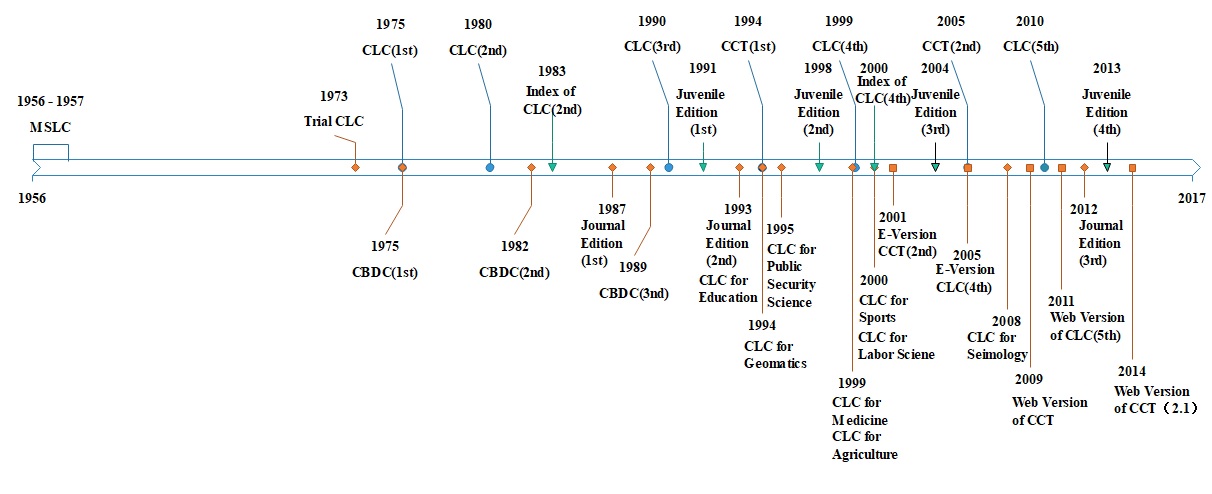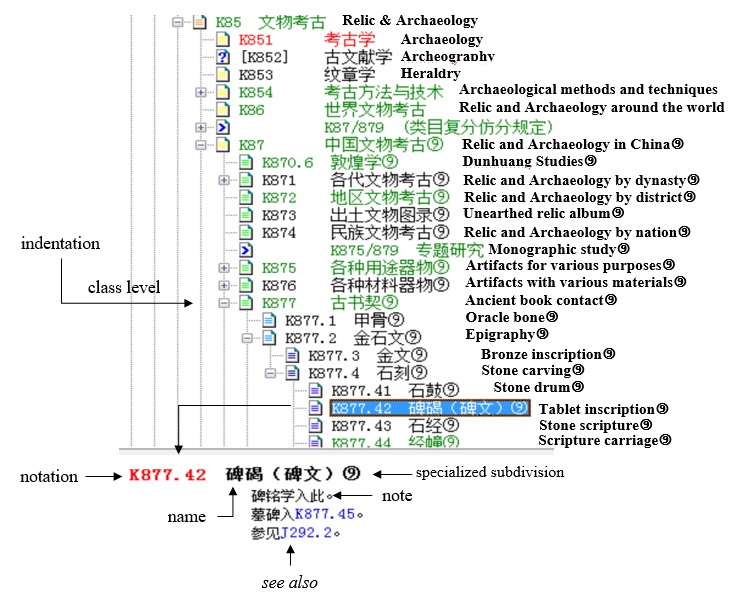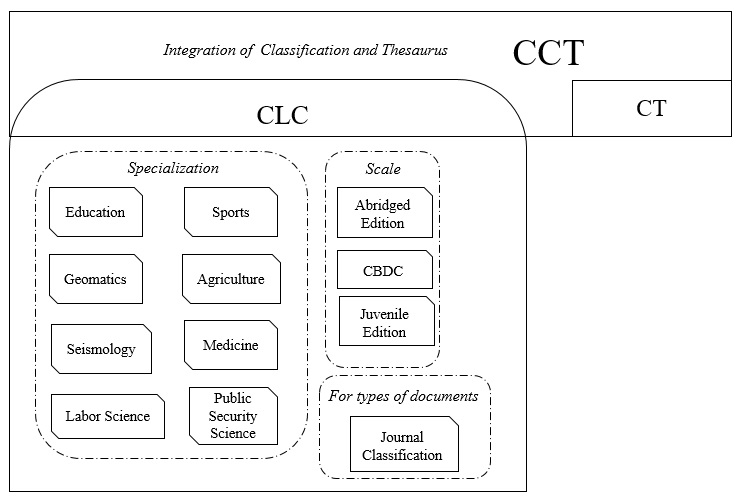I S K O
Encyclopedia of Knowledge Organization
Chinese Library Classification (CLC)
by Shuqing Bu
translated by Wei FanTable of contents:
Colophon
1. A brief history
2. The scheme
3. Notation system
4. The CLC series
5. Summary
Acknowledgement
References and further readingsAbstract:
The Chinese Library Classification (CLC), formerly known as Chinese Library Book Classification has been a representative, large, and comprehensive classification since the founding of the People's Republic of China in 1949. The 1st edition was published in 1975. The 4th edition of CLC was merged with the Chinese Book and Document Classification in 1999. Since then, the title "Chinese Library Classification" was officially established and CLC is used for its English abbreviation. The 5th edition of CLC was published in August 2010. CLC is widely used in libraries and information institutions in China. It is also the foundation for a set of specialized Chinese classifications designed for all different kinds of libraries and information institutions in China.
1. A brief history
The development and continuous updates of CLC is to satisfy the needs of classifying and retrieving the Chinese and foreign information resources in various Chinese libraries and information institutions (CLC 2017). Its predecessor could be traced back to the Draft of Medium and Small Library Classification (MSLC) which was a product from the Social and Cultural Affairs Administration of the Ministry of Culture of China created between 1956-1957. The launch of the MSLC indicated that, from the beginning, CLC was managed by the editorial committee which was dominated by the Chinese government for establishing a basis for compiling a unified large classification. The five divisions and the mixed notation style of MSLC was inherited by CLC.
Since MSLC was published, many large libraries and special libraries had urgent requirements to compile a specific classification for themselves. From 1959 to 1966, while under the control of the Ministry of Culture and the Ministry of Education of China, the National Library of China (former Beijing Library) established a classification editorial group and started to compile CLC (commonly known as the "large classification"). The natural science part and social science part were respectively mimeographed in 1964 and 1966. Unfortunately, owning to historical and political reasons, the large classification was unfinished.
In February 1971, in charge of the State Administration of Cultural Heritage of China, the National Library of China had an initiative to organize an editorial group with 36 units, composed of some provincial and municipality libraries, university libraries and the Institute of Scientific and Technical Information of China (ISTC), and started to compile CLC based on the large classification. The trial edition of CLC was compiled in March 1973 and the 1st edition of CLC was published by the Scientific and Technical Documentation Press in October 1975.
In June 1979, the editorial committee responsible for maintaining the CLC and compiling some series of CLC was formally established and replaced the former editorial group. By December 2016, the eighth editorial committees, led by the National Library of China, had compiled five editions of CLC (see Figure 1 for the CLC development timeline). The 2nd edition of CLC was published by the National Library of China Publishing House (former Bibliography and Document Press) in June 1980. The 3rd edition was published in February 1990, the 4th edition was published in March 1999, and the 5th edition was published in August 2010. The electronic version of the 4th edition of CLC was published by the National Library of China Publishing House in 2001 an independently developed digital classification for machine auxiliary indexing. In 2009, the web version of the 2nd edition of the Chinese Classified Thesaurus was online (http://cct.nlc.cn/), which contained the web version of the 4th edition of CLC. In December 2011, the Web version of 5th edition of CLC was released (http://clc5.nlc.cn/).

2. The scheme
The classification system of CLC is based on general scientific principles. Additionally, it has taken full account of features and requirements of documents' subject classification and three principles (from the overall to partial, from the general to the specific, from the theory to the application), and compiled the logic category system in sequence. CLC has 5 basic categories and 22 extended divisions. Table 1 shows the basic categories, divisions and notations.
Table 1: The structure of CLC (5 main categories and 22 classes)
5 main categories 22 classes Marxism, Leninism, and
Mao Zedong Thought;
Deng Xiaoping’s TheoriesAMarxism, Leninism, and Mao Zedong Thought; Deng Xiaoping’s TheoriesPhilosophy, Religion BPhilosophy, ReligionSocial Sciences CGeneral Social ScienceDPolitics, LawEMilitaryFEconomyGCulture, Science, Education, SportsHLanguage, LinguisticsILiteratureJArtKHistory, GeographyNatural Sciences NGeneral Natural ScienceOMathematics and ChemistryPAstronomy, Earth ScienceQBiologyRMedicine, HealthSAgricultural ScienceTIndustrial TechnologyUTransportationVAeronautics, AstronauticsXEnvironmental Science, Safety ScienceGeneral Reference Works ZGeneral Reference Works
The macrostructure of the CLC has seven parts as following:
- Introduction: introduces the compilation theory and principles, classification structure and notation system, as well as a short description of compilation process and revision notes.
- Top classes table: includes a list of 22 divisions (top classes), which demonstrates the basic disciplinary categories and sequence order.
- Abridged classification table: is composed of top classes and secondary classes, representing the basic classification framework of CLC.
- Main body: includes all levels of classes and specific auxiliary tables for certain classes. It is the basic unit for categorizing and indexing documents.
- Auxiliary tables: Generality; International regions; China regions; International eras; China eras; World races and nations; China ethnic groups; Universal time, Place and Environment, and Personnel. Eight common auxiliary tables in total.
- Index: a retrieval tool to find classes from names and notes, ordered alphabetically.
- Manual: the definitive guide to explain the compilation theory and technology of CLC, rules and methods of categorizing documents, and the guidance for correct use.
In the microstructure of CLC, the main body presents the classes and subclasses, common and specific auxiliary tables. The composition contains the parts of: notation, name, class level, note, and see-also. The indentation and font indicate the class level and reveal the hierarchical relationship in the classification system. The note and see-also explain the meaning and scope of the class, classified method, and relationships with other classes. Figure 2 demonstrates a snippet of class K85 Relic & Archaeology.

The classes of CLC could be mainly divided into two types: classes for indexing and classes for non-indexing use. The non-indexing classes include three types of classes: alternative class which reveals multi-properties, indicative class which explains the usage for the range class, and stopped class which is just temporarily retained in new edition for stability in transition period.
3. Notation system
CLC has two types of → notations (Editorial Committee of CLC 2012): the basic notation and auxiliary notation. The basic notation is a combination of Latin alphabets and Arabic numerals. In general, a sign with one capital letter indicates a top class. In industrial technology and law classes, a sign in double capital letters indicates a secondary class. The other classes (secondary and lower level classes) use numeral notations arranged in decimal order. An example of notation is as follows:
DPoliticsD6Chinese PoliticsD62Political System
...D621.5Civil Right
Auxiliary notations include the following: indirect sign . , start and end sign / , alternative sign [] , generality auxiliary sign - , country and region sign () , era sign = , nationality sign "" , common time, place, environment and personnel sign <> , main nation coordination sign : ; + sign is the indicator for categorizing document, > is sign for indicative class, { } is sign for stop class, ①~⑨ is sign for subdivision with auxiliary tables, ⓧ is sign for forbidden class. These indicators are used not only to index document, but also to remind the cataloguer the class's feature, usage and scope. Sometimes it appears in middle of the class or after the class name. When notation includes auxiliary sign and the first part (A-Z, 0-9) is the same, the following order is for recommendation: - () " " = <> : .
The notation of CLC employs a hierarchical system which assigns the corresponding number of digits according to the class level. It also uses other methods, such as octal classification, double positions system, notation borrowing etc., to enhance the expansion and flexibility of the notation system. Additionally, it also uses some numbering methods such as unified numbering, corresponding numbering and null numbering to enhance the mnemonics, regularity and logic of notation.
4. The CLC series
The editorial committee of CLC organized several sub-editorial groups for certain purposes. First, to strengthen the application of IT and the Web for the maintenance and update of CLC, classification indexing and retrieval; second, to satisfy the requirements of the online cataloging for librarians and document retrieval for end users; third, to adapt the specific requirements of different libraries for classifying documents from various disciplines. These sub-editorial groups worked out the detail provision for compiling the special editions of CLC and professional classifications and has compiled and published some series of CLC and related handbooks.

-
The editions developed for any scale libraries and information institutions.
The abridged edition of CLC is a simplified version for categorizing document in a medium or small library. This edition is suitable for medium and small libraries, those with under 200,000 books. These county and district libraries could use this edition for classified shelving and categorization. Since 1975, the trial version of classification for medium and small libraries which was abridged from the 1st edition of CLC has synchronized with CLC and published the 5th edition.
The Chinese Book and Document Classification (CBDC) is suitable for categorizing articles and papers and has synchronized with CLC. The 1st edition of CBDC was compiled in 1971 and published in 1975. The 2nd edition and 3rd edition respectively were published in 1982 and 1989. The editorial group of CBDC was separated from the editorial committee of CLC and established as an independent editorial board in 1995. This board was in charge of CBDC's revision, publication and management. In 1999, the editorial committee of CLC merged CBDC into CLC and renamed as the 4th edition of CLC, in which the
+sign was used in notation to indicate the solo applicable target on categorizing articles and papers, not books.The special edition of CLC for juvenile libraries formerly known as CLC for Children’s Library and Elementary and Secondary library (referred to as Children’s Library Classification). It is compiled for elementary and secondary school library collections and young readers. In 1990, the sub editorial group of CLC for children library was established. The 1st edition of CLC for children’s library was based on the 3rd version and 4th version of CLC and published in 1991; the 2nd edition was released in 1998 and the 3rd edition in 2004. To satisfy the classification requirements of the juvenile libraries, according to the revision of children’s library part from the 5th edition of CLC, the special edition of CLC for juvenile libraries was established and officially published as the 4th edition in November 2013. Every edition was distributed with a supplementary handbook.
- The editions developed for different types of documents.
The Journal Classification of CLC (hereafter referred to as the Journal Classification) is developed to satisfy the classified shelving and retrieval requirements for the Chinese and foreign journals. The editorial committee of CLC began to compile the Journal classification since 1985. The 1st edition of the Journal Classification was published in 1987, the 2nd edition in 1993 and the 3rd edition in 2012.
- The editions for classifying and subject indexing and retrieval.
In charge of the editorial committee of CLC, 40 libraries and information institutions participated to compile the Chinese Classified Thesaurus (CCT), which was an integrated tool of classification and subject retrieving, based on the comparable notation between CLC and Chinese Thesaurus, a national standard. In a sense, CCT is also regarded as the index of CLC. The 1st edition of CCT was published by the Huayi publishing house in 1994. The 2nd edition and electronic version of CCT was published by the Beijing Library Press in September 2005. The web version of CCT powered by the National Library of China was online in 2009. The 2.1 web version of CCT which corresponds with the 5th edition of CLC was updated in January 2014.
- The web version for computerized cataloging for librarians and classified retrieval by end users.
In 2001, the editorial committee of CLC and Beijing Data Trans Software Co., Ltd. jointly developed the electronic version of CLC with multi-functional retrieval and multi-windows display. Its classification data came from the MARC database of the 4th edition of CLC and the classification structure which based on Windows platform had dynamic hypertext function. The National Library of China published two CD-ROM distributions for standalone computers and LAN (Local Area Network) in the same year. The electronic version of CLC was a milestone of Chinese classifications which indicated the transition from paper-based printed classification to paperless electronic classification. The fixed order and static layout were replaced by dynamic retrieval and hypertext function with multi-windows layout. It was also used for documents’ indexing and retrieving in standalone or online environments.
In 2009, the web version of the Chinese Classified Thesaurus (CCT) was developed by the editorial committee of CLC and published the corresponding index of CLC and CT in the form of web pages for Internet users. It has been regarded as a live knowledge organization system and service platform to provide knowledge organization and retrieval, as well as subject navigation for various information resources. It could update the classes and descriptors in real time and connect with various OPACs to provide quick federated search and subject navigation for end users (readers). The web of CCT is the first comprehensive knowledge organization service platform for global Chinese. In 2011, the editorial committee of CLC published the web version of the 5th edition of CCT separately.
- The editions developed for specialized libraries and information institutions.
To satisfy various classifying levels for different special libraries and information institutions, the editorial committee of CLC decided to compile a series based on CLC. By now, the series include CLC for Education (1993), CLC for Geomatics (1994), CLC for Public Security Science (1995), CLC for Agriculture (1999), CLC for Medicine (1999), CLC for Sports (2000), CLC for Labor Science (2000), CLC for Seismology (2008) and so on. These editions were derived from CLC and complied with the compilation principles, schemes, and notations of CLC. They were published by the National Library of China Publishing House or the professional document presses.
- An alphabetical browsing tool for finding classes.
The index of CLC is a class finding tool for subject retrieval purpose. The indexes of the 2nd edition and the 4th edition of CLC were respectively published by the National Library of China Publishing House in 1983 and 2000. The indexes of the 3rd edition and the 4th edition of CLC were respectively replaced by the 1st edition and 2nd edition of CCT.
5. Summary
CLC is a typical hierarchical classification system. It includes complex hierarchical structure and defines clearly hierarchical and parallel relationships. It combines the classified retrieval function with the book shelving function. The sustainable development of CLC depends on the revision mechanism and user-centered series products with the editorial committee's great efforts. At present, most Chinese libraries and information institutions use CLC to classify, categorize, organize and shelve documents. It grounds the basis of unified documents’ classification data and provides users the searching and retrieval of documents from discipline perspectives.
Acknowledgment
We are grateful to prof. Marcia Zeng for the helpful suggestions and proofreading.
References and further readings
CLC (Chinese Library Classification). 2017. About CLC. http://clc.nlc.cn/ztfls.jsp.
The Editorial Committee of CLC. 2012. Manual of the 5th edition of the Chinese Library Classification. Beijing: National Library of China Publishing House.
Hu, Yuefang and Yintao Chen. 2007. “Differences between the DDC and the CLC in classifying works of literature”. Illinois Libraries 86, no. 4: 5-10.
Liu, Maggie, Lolita Kwok and Kylie Chan. 2012. “Why change to the Chinese classification scheme? A case study in an academic library”. Cataloging & classification quarterly 50, no. 8: 852-868. DOI: http://dx.doi.org/10.1080/01639374.2012.680684
Liu, Xiaochun. 1993. “The standardization of Chinese Library Classification”. Cataloging & classification quarterly 16, no. 2.
Wang, Jun. 2003. “A knowledge network constructed by integrating classification, thesaurus, and metadata in digital library”. International information & library review 35, no. 2-4: 383-397.
Zhang, Qiyu, Xiangsheng Liu and Dongbo Wang. 1996. “Contemporary classification systems and thesauri in China”. 62nd IFLA General Conference – Conference Proceedings – August 25-31, 1996 [online] Available at: http://archive.ifla.org/IV/ifla62/62-qiyz.htm.
Zhang, Wenxian. 2003. “Classification for Chinese Libraries (CCL): histories, accomplishments, problems and its comparisons” Journal of educational media and library sciences 41, no. 1: 1-22.
Zhang, Yihua, Jia Peng, Do Huang and Fang Li. 2011 “Design of Automatic Mapping System between DDC and CLC”. In: Digital libraries: for cultural heritage, knowledge dissemination, and future creation: ICADL 2011. Edited by Xing C., Fabio Crestani and Andreas Rauber. Lecture Notes in Computer Science 7008: 357-366. Berlin: Springer.
Visited times since 2019-11-14 (almost 2 years after first publication).
Version 1.0; published 2017-12-14, last edited 2019-11-14
Article category: KOS, specific (general/universal)
©2017 ISKO. All rights reserved.